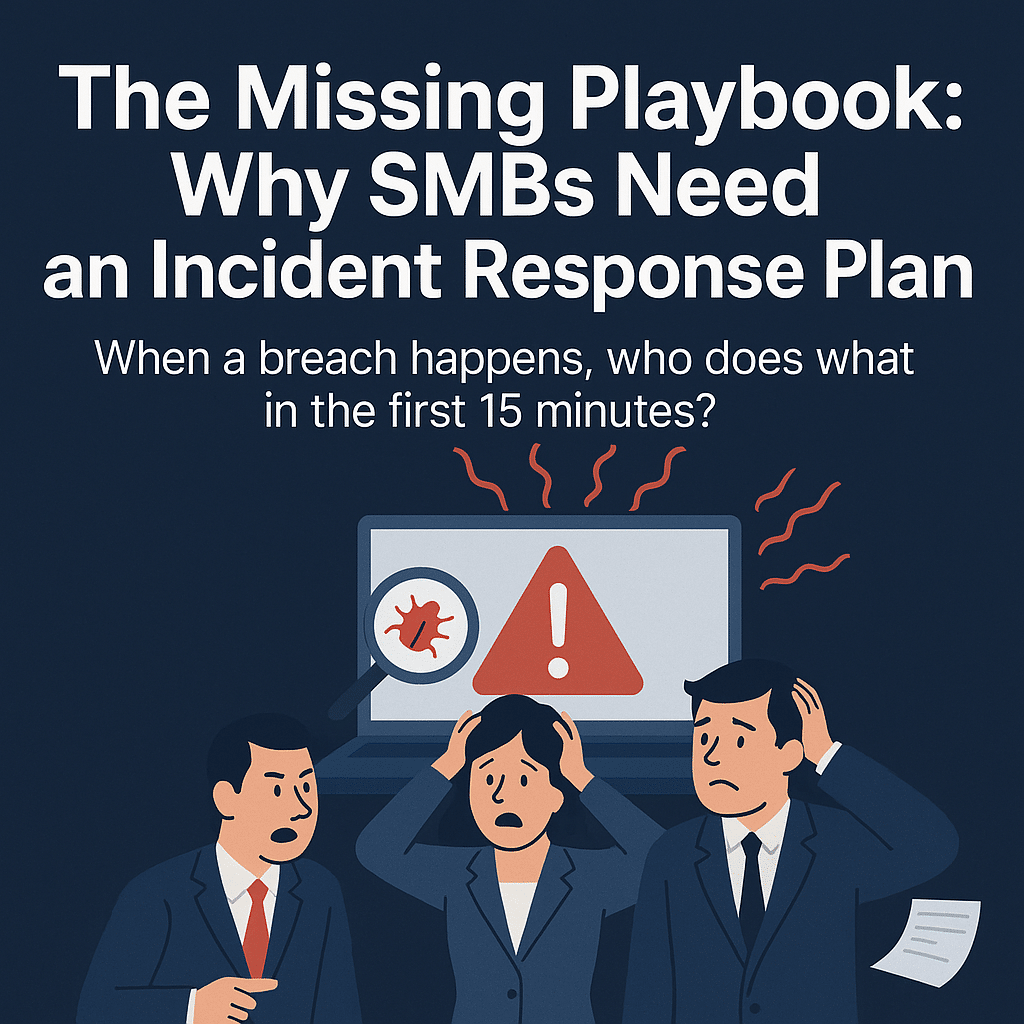The Missing Playbook: Why SMBs Need an Incident Response Plan
When a breach happens, who does what in the first 15 minutes? If you can’t answer this immediately, your organization has a critical vulnerability that could transform a manageable incident into a business catastrophe.
While SMB leaders often acknowledge that cybersecurity is important, most operate without the one tool that determines whether a security incident becomes a minor disruption or a major disaster: a formal incident response plan.
The absence of a clear playbook doesn’t just create confusion—it creates cascading failures that multiply damage, extend recovery time, and exponentially increase costs. When seconds count and every decision matters, the last thing you want is a leadership team standing around asking “what do we do now?”
🚨 For SMBs, the choice isn’t whether to invest in incident response planning—it’s whether to plan for success or accept the chaos that destroys unprepared businesses.
What Happens Without a Plan: The Chaos Tax
Confusion and Decision Paralysis
Without predefined procedures, even the most capable leadership teams become paralyzed when faced with security incidents. Questions that should have clear, immediate answers—Who has authority to shut down systems? When do we call law enforcement? How do we preserve evidence?—become debate topics during the worst possible time.
This confusion isn’t academic. While teams spend critical hours debating basic response procedures, attackers continue operating unopposed. What could have been contained in minutes spreads throughout the network, turning isolated incidents into enterprise-wide compromises.
⚠️ The window for containing security incidents is often measured in minutes, not hours. Organizations that waste this critical time window due to poor planning typically face dramatically higher recovery costs and longer business disruption.
Finger-Pointing and Accountability Failures
Security incidents create stress, and stress reveals organizational weaknesses. Without clear roles and responsibilities defined in advance, incidents quickly devolve into finger-pointing exercises that waste critical time and destroy team cohesion.
IT teams blame security teams for inadequate controls. Security teams blame users for clicking malicious links. Management blames everyone for not preventing the incident. Meanwhile, the actual incident continues escalating while the organization focuses on assigning blame rather than containing damage.
The Value of an IR Plan: From Chaos to Control
Faster Containment = Reduced Breach Costs
Organizations with formal incident response teams and tested plans can contain breaches 54 days faster than unprepared organizations. This time difference translates directly into cost savings—every day a breach continues uncontained adds thousands of dollars in additional damage.
💰 Organizations that contain breaches within 30 days save over $1 million compared to those requiring longer containment periods.
Benefits of an Incident Response Plan
🎯 Defined Roles and Responsibilities: Eliminate confusion and decision paralysis with clear authority structures
📢 Clear Communication: Pre-developed templates ensure consistent messaging to leadership, customers, and regulators
🏆 Builds Resilience and Customer Trust: Demonstrate professional maturity and competitive advantage
Bridging to External Partners: When Plans Need Professional Support
The Reality of SMB Resource Constraints
Even the best incident response plans require resources that most SMBs don’t possess internally. Digital forensics, legal expertise, and 24/7 monitoring capabilities typically exceed the practical limits of internal IT teams already managing day-to-day operations.
The most effective approach combines internal incident response planning with external expert partnerships. Internal teams handle immediate response actions while external specialists provide advanced capabilities like forensic investigation, legal guidance, and regulatory compliance support.
Positioning Retainers as the Safety Net
For SMBs with limited internal resources, incident response retainers function as essential safety nets that ensure professional response capabilities are available when needed. Retainers provide access to specialized expertise that would be prohibitively expensive to maintain internally.
The retainer model aligns perfectly with SMB operational realities. Instead of hoping internal teams can handle complex incident response challenges, organizations can focus on initial response while professional specialists handle advanced investigation and remediation.
Incident Response Retainers: Provide guaranteed access to expert capabilities with pre-negotiated terms and immediate activation procedures.
Business Continuity Protection: Ensure incident response capabilities aren’t dependent on the availability of specific internal personnel.
The Choice is Yours: Plan for Success or Accept Chaos
The question facing SMB leaders isn’t whether security incidents will occur—it’s whether they’ll be prepared to respond effectively when they do. Organizations with comprehensive incident response plans control their destiny during crises, while unprepared organizations become victims of circumstances beyond their control.
Incident response planning represents one of the highest-return investments in business continuity. The cost of developing comprehensive response capabilities pales in comparison to the potential costs of chaotic crisis response.
🚨 For SMBs serious about long-term success, incident response planning isn’t optional—it’s essential infrastructure for operating safely in the digital age. The time to prepare is now, before the crisis that tests whether your business is built to survive.

